-
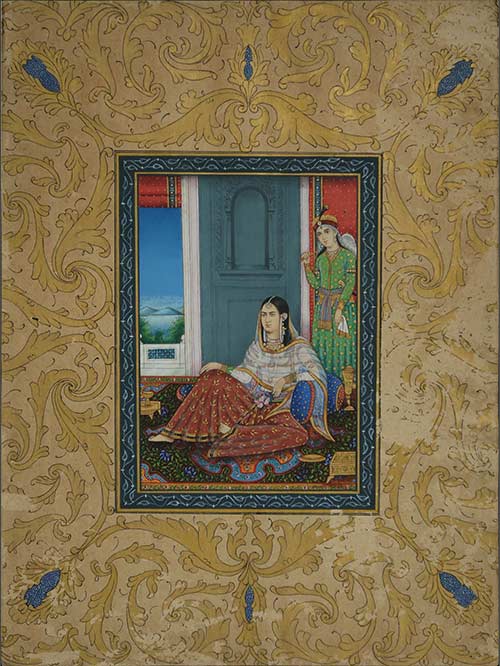
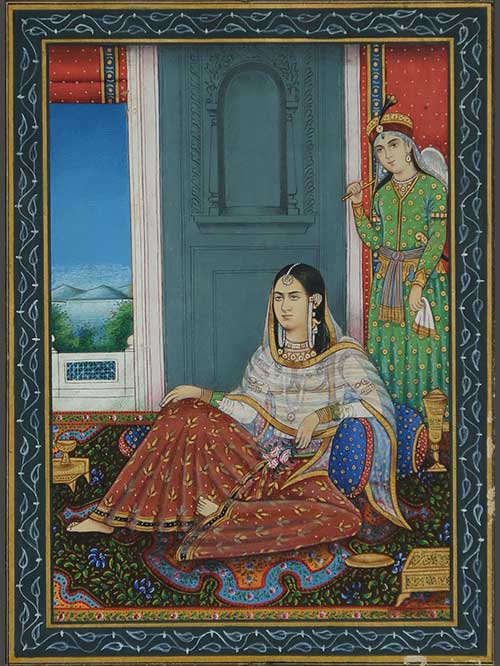
Delhi
pigments and gold on paper, painted gilt arabesque borders
A finely painted portrait of a seated lady, most likely a courtesan, as suggested by her stance and attire. She wears loose fitting pyjamas and a bodice under a diaphanous odhani or veil and is seated against a large blue bolster. A female attendant stands behind her holding a fly-whisk. Assorted gilded cups and a betel box are placed beside her on an intricately patterned floral carpet. A scene of a moonlit lake and hills visible in the distance through a marbled balcony.
Courtesans (tawaifs) occupied an honoured place in the Muslim cultures of India, especially in Lucknow and Delhi. They were trained to be women of great refinement, skilled in music and dancing and appreciative of courtly literature in Persian and Urdu. Their company was eagerly sought by the great men of Delhi, and they would entertain their visitors by performing a nautch (dance).
Miniature Size (cms): 18.3 (L) x 13.5 (W)
Miniature Size (inch): 7.2 (L) x 5.3 (W)
Page Size (cms): 33.5 (L) x 25 (W)
Page Size (inch): 13.2 (L) x 9.8 (W)
-
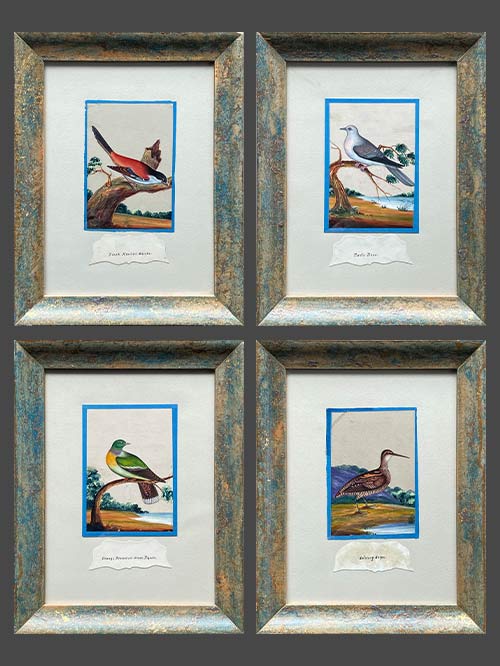
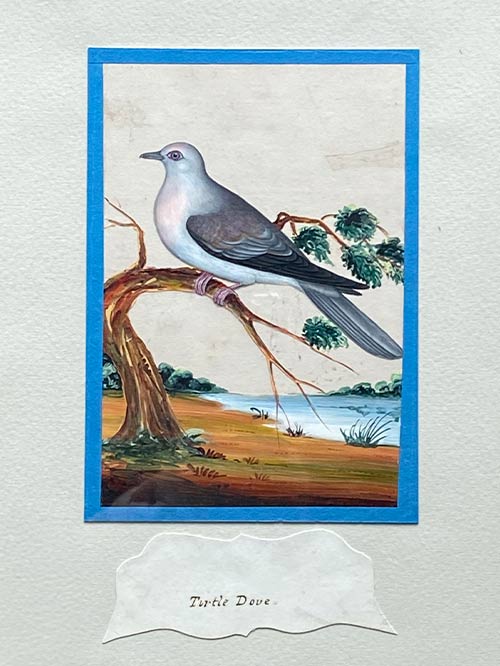
Trichinopoly (South India)
Pigments on Mica
Painting on mica (talc) was a novelty that greatly attracted the British in India and was made specifically for Europeans. Mica had long been used by Indian artists for preserving tracings of their family paintings. It was practised at Murshidabad, Patna and Benares in Eastern India and at Trichinopoly in South India. In South India mica was mined at Cuddapah and painted by artists at Trichinopoly. By the second half of the nineteenth century mica paintings depicting gods, rulers, festival scenes, castes, occupations, birds, flowers and butterflies were being produced there in their hundreds for sale to the British. South Indian mica painting is easily distinguished from that in Eastern India by its colour range, with arsenic green, lemon yellow and orange-brown predominating. Those in Eastern India favoured a blue.
This set of four mica paintings, each depicting a different bird, features original handwritten captions identifying each species. The birds showcased include the Black Headed Shrike, Turtle Dove, Orange Breasted Green Pigeon, and Solitary Snipe.
Painting Sizes (cms): 14(H) x 10.5(W) each
Painting Sizes (inches): 5.5(H) x 4.25(W) each
Framed Sizes (cms): 32.5(H) x 25.5(W) each
Framed Sizes (inches): 13(H) x 10(W) each
-
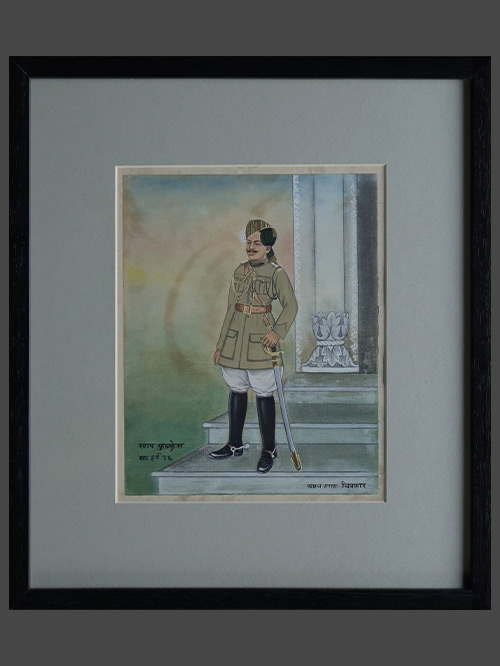
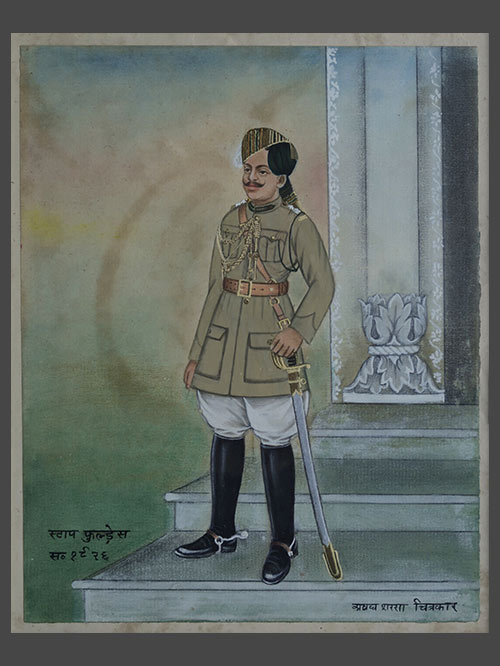
Rewa (Central India)
pigments on paper
Company Painting, Signed by the artist Avadh Sharan
A charming Company painting of a Staff officer captioned, “Staff Full-dress 1926.” Military personnel were chiefly shown in full dress by-military artists and photographers. Yet the undress uniform is equally important since the greater part of the military personnel’s daily life was spent in their undress uniform. Full-dress uniform, also known as a ceremonial dress uniform or parade dress uniform, is the most formal type of uniforms used by military and police. Full-dress uniforms typically include full-size orders and medals insignia.
The military staff was a group of officers, enlisted and civilian staff who serve the commander of a division or other large military unit in his command in a control role through planning, analysis, and information gathering, as well as by relaying, coordinating, and supervising the execution of his plans and orders. During this period, the Indian army was a separate organisation to the British Army. The main task of the Indian Army was to police the Indian Empire. During the first and second world wars, Indian troops served with distinction in France in 1940, Egypt, Libya, the Sudan, Abyssinia, Syria, Persia, Iraq, Malaya and Burma.
Painting Size (cms): 22 (H) x 18 (W)
Painting Size (inch): 8.5 (H) x 7 (L)
Framed Size (cms): 36.5 (H) x 32 (W)
Framed Size (inch): 14.5 (H) x 12.5 (L)
-
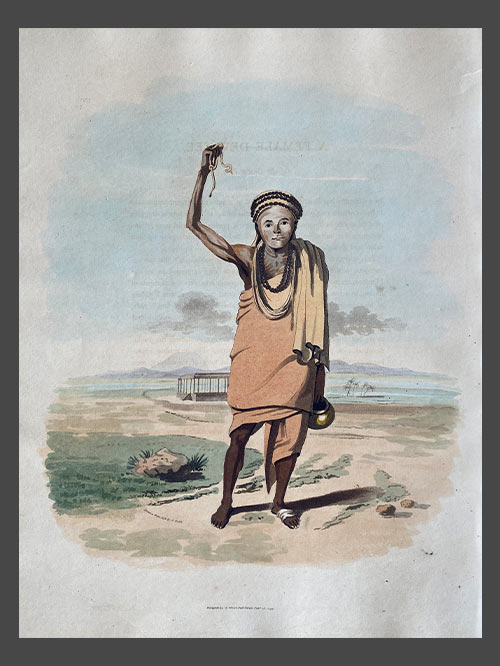
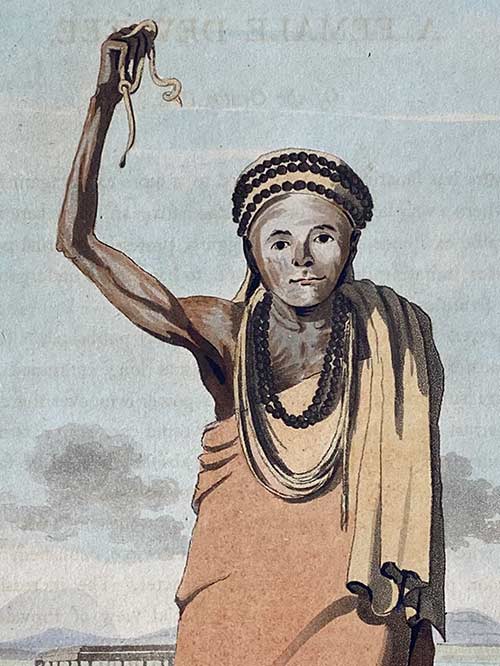
Pub. London
original hand-coloured aquatint
Captain Charles Gold (d. 1842) served in the military campaigns against Tipu Sultan, the ruler of the Kingdom of Mysore and during 1791-98 he sketched a series of images later published as aquatints in “Oriental Drawings.” He was fascinated with the concept of religious begging and documented all manners of mendicants and zealots that he met on his travel, often detailing their unique trials and tribulations.While these prints cannot be divorced from the orientalist roots from which they came, they are a compelling visual memoir of a time and people that may have otherwise been lost to time.
The devotee drawn by the artist, “made a vow, in order to gain favour with the gods, to keep her right arm uplifted, and let the finger nails of that hand grow for twelve years. The cord worn round her neck she used for the purpose of tying up her arm at night when going to rest. Her hand being nearly closed, the thumb nail arched directly over it, the fore finger nail assumed a spiral or cork-screw form, that of the middle took an extraordinary direction, encircling the little finger nail, which grew more regularly than the others, and descended about half way to her elbow, the remaining or fourth nail being broken off half an inch from the finger end. She had adopted the orange coloured dress usually worn by the religious orders in India; and being subsisted entirely by the liberality of the devout, who regarded her as a saint, travelled the country with a brass pot, to receive their pious donations in. Her face, right arm, and neck, were smeared over with a white powder. The ornaments round her head and neck are seeds of a fruit which grows in the north of India, called the nut of Rouderin. The cloth round her right foot was merely to cover a hurt received in travelling, as she did not indulge with shoes. In the distance is a Choultry, built at the expence of some charitable Gentoo, for the accommodation of travellers.”
Size (cms): 33(H) x 25(W)
Size (inches): 13(H) x 10(W)
-
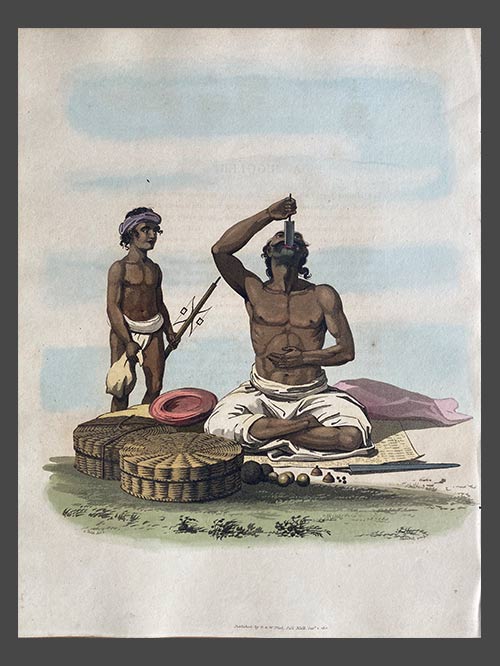
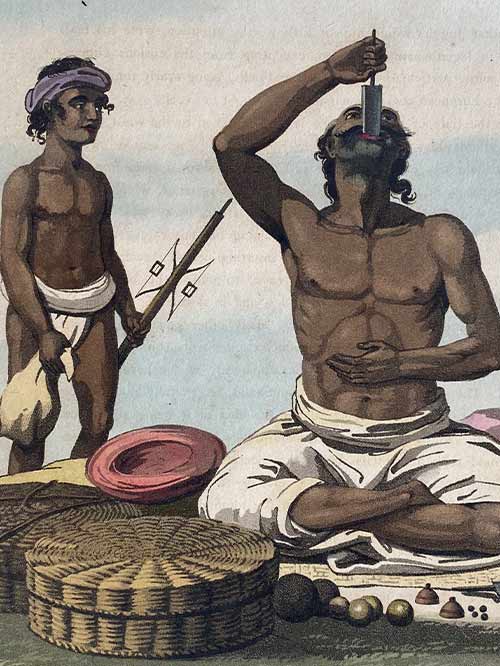
Pub. London
original hand-coloured aquatint
Captain Charles Gold (d. 1842) served in the military campaigns against Tipu Sultan, the ruler of the Kingdom of Mysore and during 1791-98 he sketched a series of images later published as aquatints in “Oriental Drawings.” He was fascinated with the concept of religious begging and documented all manners of mendicants and zealots that he met on his travel, often detailing their unique trials and tribulations.While these prints cannot be divorced from the orientalist roots from which they came, they are a compelling visual memoir of a time and people that may have otherwise been lost to time.
Fascinated by his encounter, the artist recounts “the Juggler in the usual attitude of putting the sword-blade down his throat; is seated on a mat, with his cups and balls before him; also two heavy stone balls, which he throws alternately to a great height, and catches on his bare back. The baskets contain his various apparatus, and the little fellow, his son and apprentice, holds a small whirling instrument, which he balances and plays various tricks with. His dress and turban lay on the ground behind. The most surprising of his performances, which consist of various distortions of his person, is to raise by the strength of his eyelids, two baskets containing his apparatus, being of several pounds weight. That which excites wonder in the greatest degree is the swallowing a sword blade, apparently at the hazard of his existence. The practicability of this experiment, is generally doubted by those who have not witnessed it; under the idea of it being performed with a spring sword. He swallowed to the very hilt the blade of a broad-sword, blunted in the edges and point, and about eighteen inches long, which I absolutely felt in his stomach. As may be supposed, the exertion and straining affects the poor fellow a good deal at the time, but a glass or two of arrack or brandy which he never fails to ask for, soon refreshes him.”
Size (cms): 33(H) x 25(W)
Size (inches): 13(H) x 10(W)
-
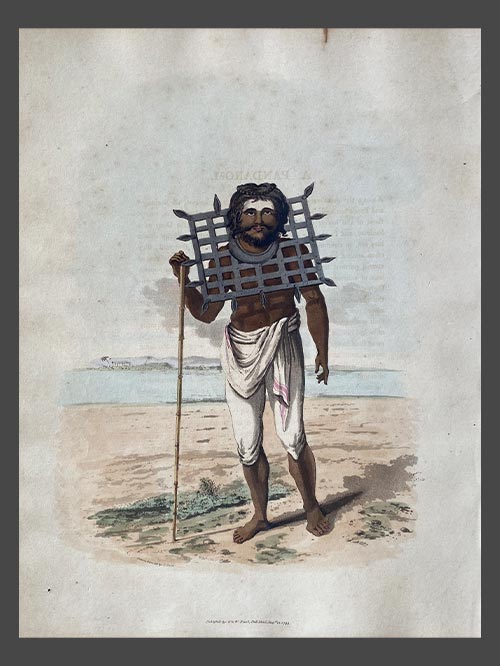
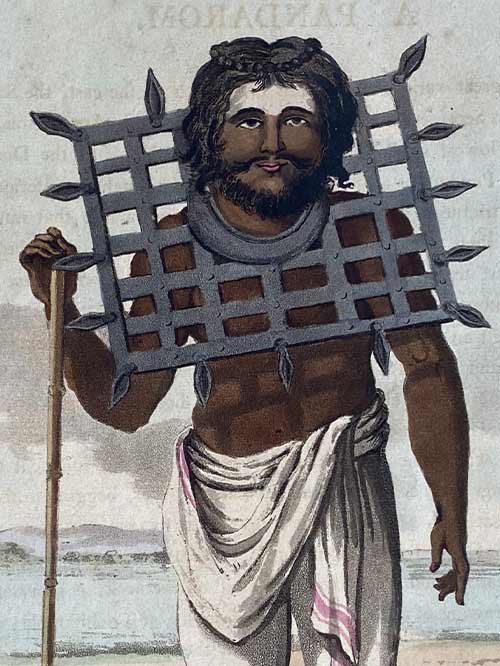
Pub. London
original hand-coloured aquatint
Captain Charles Gold (d. 1842) served in the military campaigns against Tipu Sultan, the ruler of the Kingdom of Mysore and during 1791-98 he sketched a series of images later published as aquatints in “Oriental Drawings.” He was fascinated with the concept of religious begging and documented all manners of mendicants and zealots that he met on his travel, often detailing their unique trials and tribulations.While these prints cannot be divorced from the orientalist roots from which they came, they are a compelling visual memoir of a time and people that may have otherwise been lost to time.
The artist describes his interaction with the mendicant he drew “from life at Trichinopoly; whither he had travelled to attend a grand festival at the celebrated Pagoda on the isle of Seringham. The grate he wore was encompassed by sixteen small lamps, which on particular occasions he caused to be illuminated. He usually wore his grate in an horizontal position, as it then rested on his shoulders with more ease. His forehead was whitened with cow-dung ashes, and his head ornamented with a circular string of the nuts of Rouderin. Among the great variety of religious enthusiasts in the east, the Saniassy and Pandarom Sects are held in the highest veneration. Under the vow of eternal poverty, temperance, and chastity, these people, with every appearance of contentment, lead a wandering and precarious existence, being entirely dependent on alms. There are instances of some, who have vowed never more to speak, others form a resolution to continue in an upright posture, without ever lying down; and to prevent the possibility of sleeping in comfort, wear an iron grate, closely rivetted on the neck,” as represented in this hand-coloured aquatint.
Size (cms): 33(H) x 25(W)
Size (inches): 13(H) x 10(W)
-
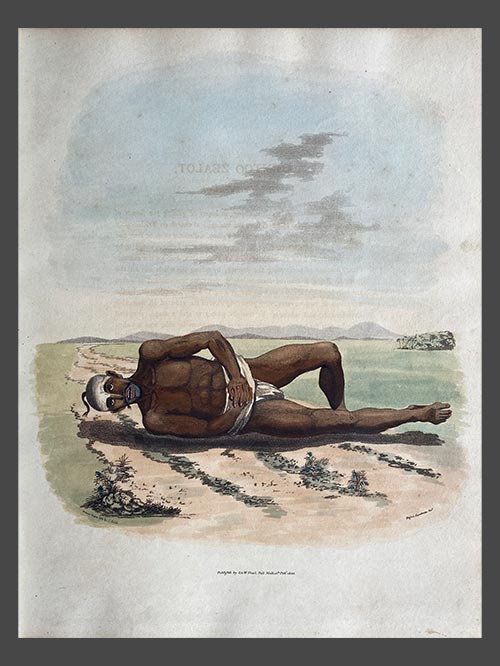
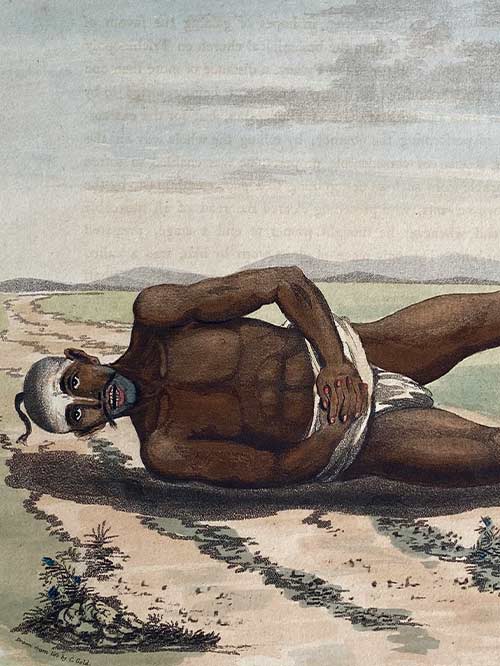
Pub. London
original hand-coloured aquatint
Captain Charles Gold (d. 1842) served in the military campaigns against Tipu Sultan, the ruler of the Kingdom of Mysore and during 1791-98 he sketched a series of images later published as aquatints in “Oriental Drawings.” He was fascinated with the concept of religious begging and documented all manners of mendicants and zealots that he met on his travel, often detailing their unique trials and tribulations.While these prints cannot be divorced from the orientalist roots from which they came, they are a compelling visual memoir of a time and people that may have otherwise been lost to time.
The artist remarked on his encounter with this “Gentoo Zealot,” who was “rolling through the fort of Trichinopoly, in the exact posture this drawing represents, and singing, or rather crying aloud, the praises of his God. The person represented in this drawing, in hopes of gaining the favour of his God, had resolved to travel from the brahminical church on Trichinopoly rock, to the famous temple on the hill of Pylney, a distance of more than one hundred miles, performing the journey, by rolling the whole way on the ground. Being a man of considerable property, he was enabled to soften the toils inseparable from such an undertaking, by the attentions of two servants, who preceding cleared the road of all moreable impediments, and whenever he thought proper to end a stage, prepared refreshments for him. The only piece of dress worn by him, was a calico cloth wrapped about the waist ; his hair was close shaved excepting a small lock on the back part of the crown, and his head entirely exposed to the influence of the sun and reflected heat from the ground, which it nearly touched every revolution he made.”
Size (cms): 33(H) x 25(W)
Size (inches): 13(H) x 10(W)
-
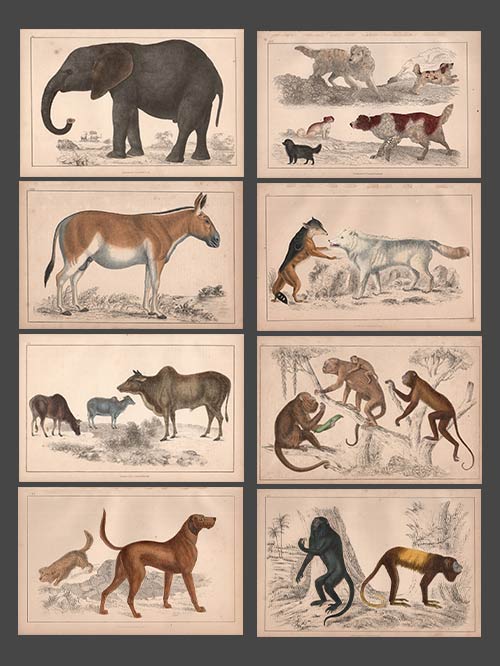
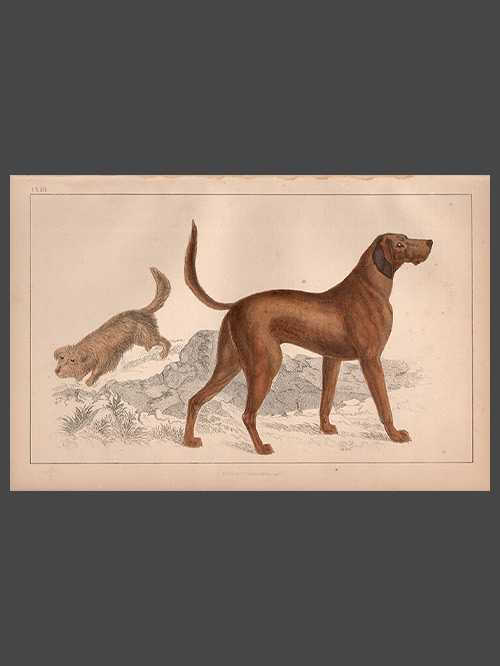
by Oliver Goldsmith
from A History of the Earth and Animated Nature
original hand coloured engravings
A History of the Earth, and Animated Nature is a work of natural history by Oliver Goldsmith that attempts to provide a description of the Earth’s geographic features and species’.
Size (cms): 16.5 (H) x 25 (L)
Size (inches): 6.5 (H) x 10 (L)
-

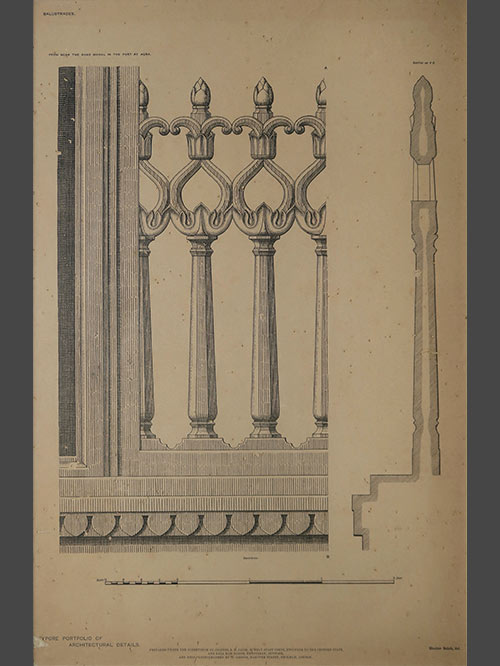
by Samuel Swinton Jacob
from Jeypore Portfolio of Architectural Details
original lithograph
Original lithographs from the Jeypore Portfolio of Architectural Details prepared with the guidance of Col. S.S. Jacob CIE, Indian Army. It depicts a sandstone balustrade from near the Khas Mahal in the Fort at Agra. The Portfolio was issued under the patronage of H.H.Maharaja Sawai Madhu Singh, G.C.S.I. of Jeypore.
The collection of drawings were executed by local draftsmen, all natives of Jeypore, trained first in the School of Art and then in the office of the Executive Engineer. They were supervised by Lala Ram Baksh, head draftsmen and teacher in the Jeypore school of Art. The architectural details depicted are mostly from mosques, tombs, palaces and other buildings in or near Delhi and Agra and parts of Rajputana. They have been arranged together in sections- each sheet loose – so that the different examples of architectural details may be compared and selections readily made. The plates would have served as working drawings for the architect and artisan.
Size Framed (cms): 68.6 (H) x 50.8 (L)
Size Framed (inches): 27 (H) x 20 (L)
-
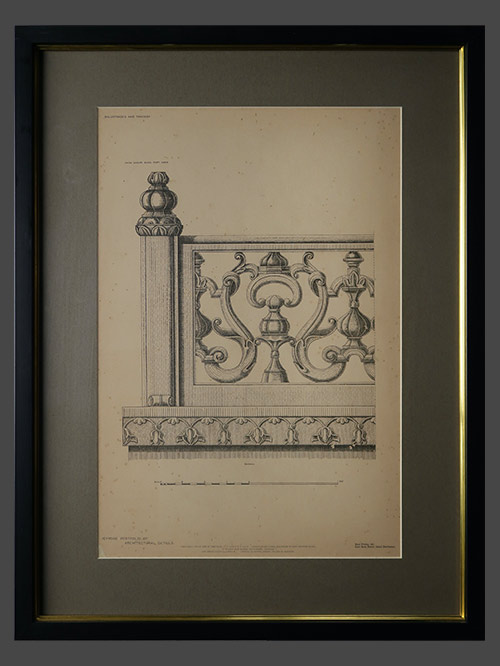
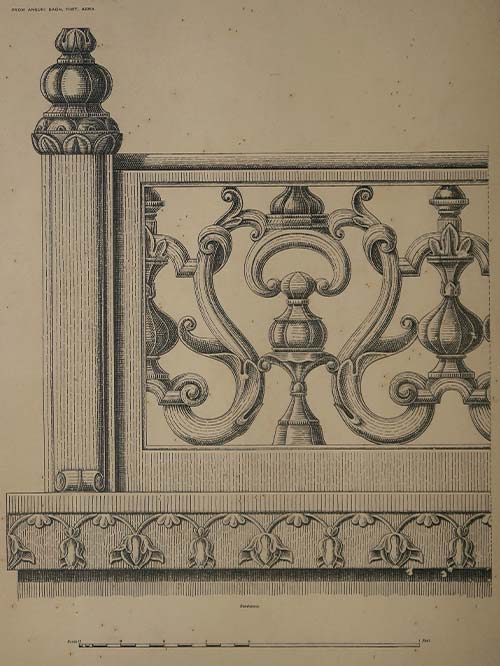
by Samuel Swinton Jacob
from Jeypore Portfolio of Architectural Details
original lithograph
Original lithographs from the Jeypore Portfolio of Architectural Details prepared with the guidance of Col. S.S. Jacob CIE, Indian Army. It depicts a sandstone balustrade from Anguri Bagh, Fort at Agra. The Portfolio was issued under the patronage of H.H.Maharaja Sawai Madhu Singh, G.C.S.I. of Jeypore.
The collection of drawings were executed by local draftsmen, all natives of Jeypore, trained first in the School of Art and then in the office of the Executive Engineer. They were supervised by Lala Ram Baksh, head draftsmen and teacher in the Jeypore school of Art. The architectural details depicted are mostly from mosques, tombs, palaces and other buildings in or near Delhi and Agra and parts of Rajputana. They have been arranged together in sections- each sheet loose – so that the different examples of architectural details may be compared and selections readily made. The plates would have served as working drawings for the architect and artisan.
Size Framed (cms): 68.6 (H) x 50.8 (L)
Size Framed (inches): 27 (H) x 20 (L)
-
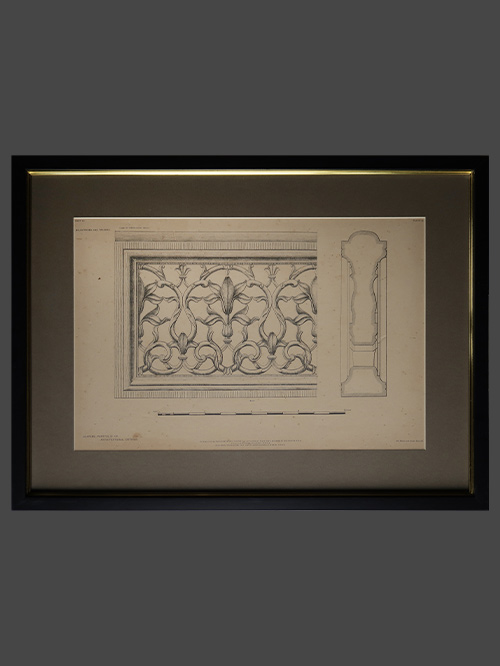
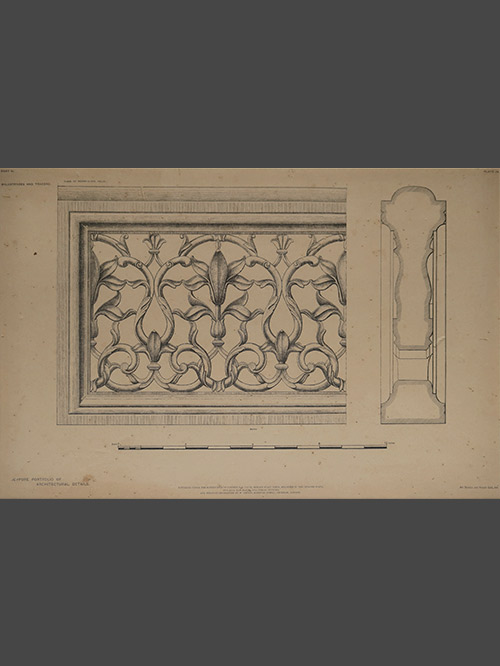
by Samuel Swinton Jacob
from Jeypore Portfolio of Architectural Details
original lithograph
Original lithographs from the Jeypore Portfolio of Architectural Details prepared with the guidance of Col. S.S. Jacob CIE, Indian Army. It depicts a sandstone balustrade from the tomb of Nizam-U-Din, Delhi. The Portfolio was issued under the patronage of H.H.Maharaja Sawai Madhu Singh, G.C.S.I. of Jeypore.
The collection of drawings were executed by local draftsmen, all natives of Jeypore, trained first in the School of Art and then in the office of the Executive Engineer. They were supervised by Lala Ram Baksh, head draftsmen and teacher in the Jeypore school of Art. The architectural details depicted are mostly from mosques, tombs, palaces and other buildings in or near Delhi and Agra and parts of Rajputana. They have been arranged together in sections- each sheet loose – so that the different examples of architectural details may be compared and selections readily made. The plates would have served as working drawings for the architect and artisan.
Size Framed (cms): 68.6 (H) x 50.8 (L)
Size Framed (inches): 27 (H) x 20 (L)
-

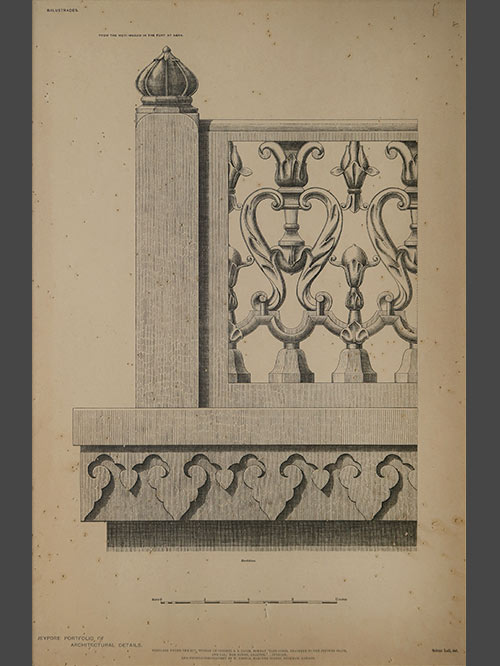
by Samuel Swinton Jacob
from Jeypore Portfolio of Architectural Details
original lithograph
Original lithographs from the Jeypore Portfolio of Architectural Details prepared with the guidance of Col. S.S. Jacob CIE, Indian Army. It depicts a sandstone balustrade from the Motif Masjid in the Fort at Agra. The Portfolio was issued under the patronage of H.H.Maharaja Sawai Madhu Singh, G.C.S.I. of Jeypore.
The collection of drawings were executed by local draftsmen, all natives of Jeypore, trained first in the School of Art and then in the office of the Executive Engineer. They were supervised by Lala Ram Baksh, head draftsmen and teacher in the Jeypore school of Art. The architectural details depicted are mostly from mosques, tombs, palaces and other buildings in or near Delhi and Agra and parts of Rajputana. They have been arranged together in sections- each sheet loose – so that the different examples of architectural details may be compared and selections readily made. The plates would have served as working drawings for the architect and artisan.
Size Framed (cms): 68.6 (H) x 50.8 (L)
Size Framed (inches): 27 (H) x 20 (L)
-
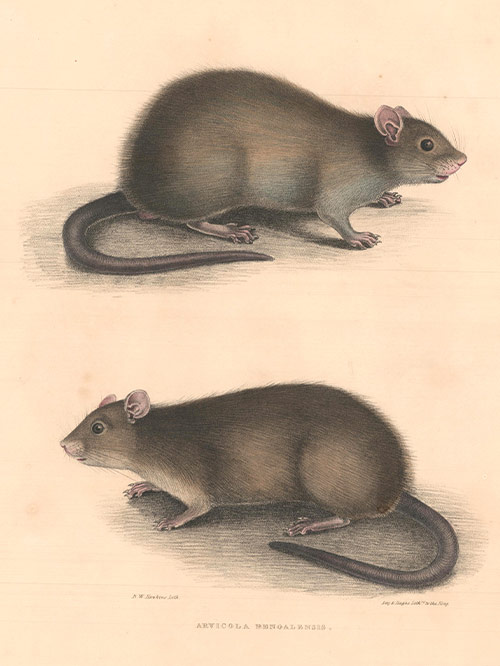
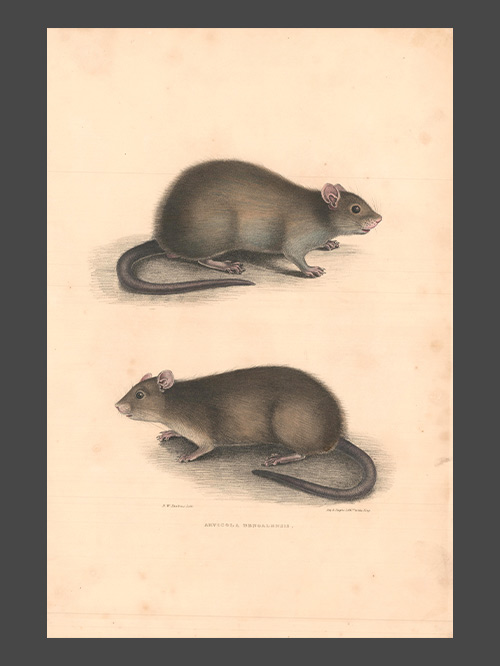
by John Edward Gray’s
From ‘Illustrations of Indian Zoology’
original hand coloured lithograph
Captioned ‘Arvicola Bengalensis’
John Edward Gray of the British Museum had collaborated with Maj.-Gen. Hardwicke in producing Illustrations of Indian Zoology between 1830 and 1834. He was also the author of several major illustrated works on natural history and commissioned the best artists and printers of the day to illustrate his work. The Illustrations of Indian Zoology is his major work, dedicated to the East India Company, and with the striking plates of bird and animal life in the sub-continent drawn by Waterhouse Hawkins, the noted sporting artist.
Maj.-Gen. Thomas Hardwicke of the Bengal Artillery whilst serving in India from 1778 to 1823 assembled a truly impressive collection of natural history drawings by Indian and European artists whom he engaged to draw flora and fauna. On his retirement he brought the collection with him to England and a thousand of these in many volumes are now in the British library and in the British Museum (Natural History). Bird portraiture predominates in Illustrations of Indian Zoology with a token representation of mammals, reptiles and fishes.
Size (cms): 48 (H) x 34 (L)
Size (inches): 19 (H) x 13.5 (L)
-
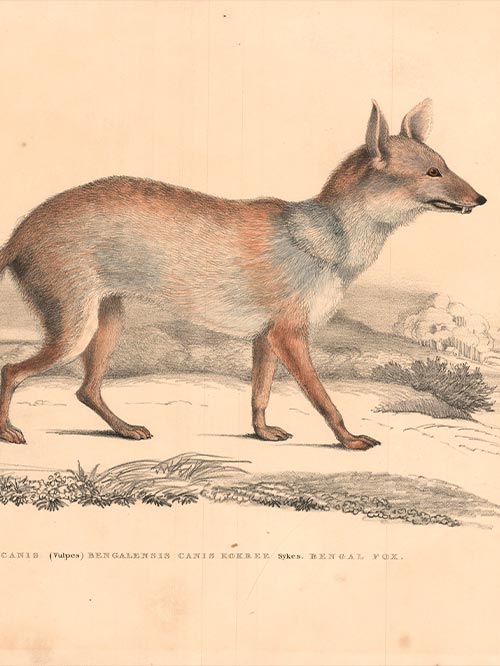
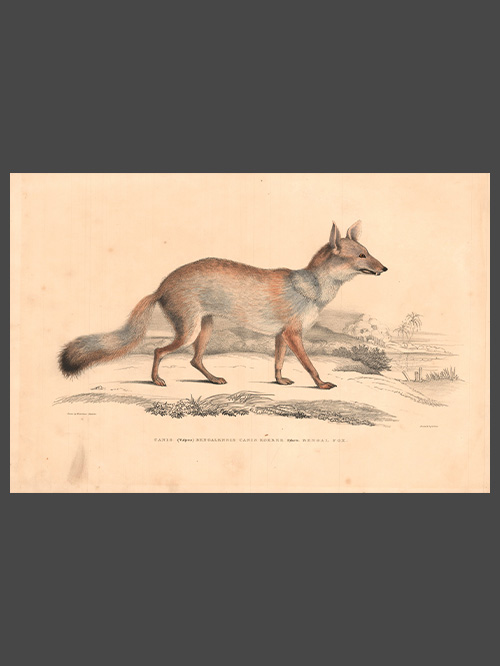
by John Edward Gray’s
From ‘Illustrations of Indian Zoology’
original hand coloured lithograph
Captioned ‘Canis (Vulpes ) Bengalensis Canis Kokree Skyes. Bengal Fox.‘
John Edward Gray of the British Museum had collaborated with Maj.-Gen. Hardwicke in producing Illustrations of Indian Zoology between 1830 and 1834. He was also the author of several major illustrated works on natural history and commissioned the best artists and printers of the day to illustrate his work. The Illustrations of Indian Zoology is his major work, dedicated to the East India Company, and with the striking plates of bird and animal life in the sub-continent drawn by Waterhouse Hawkins, the noted sporting artist.
Maj.-Gen. Thomas Hardwicke of the Bengal Artillery whilst serving in India from 1778 to 1823 assembled a truly impressive collection of natural history drawings by Indian and European artists whom he engaged to draw flora and fauna. On his retirement he brought the collection with him to England and a thousand of these in many volumes are now in the British library and in the British Museum (Natural History). Bird portraiture predominates in Illustrations of Indian Zoology with a token representation of mammals, reptiles and fishes.
Size (cms): 34 (H) x 48 (L)
Size (inches): 13.5 (H) x 19 (L)
-
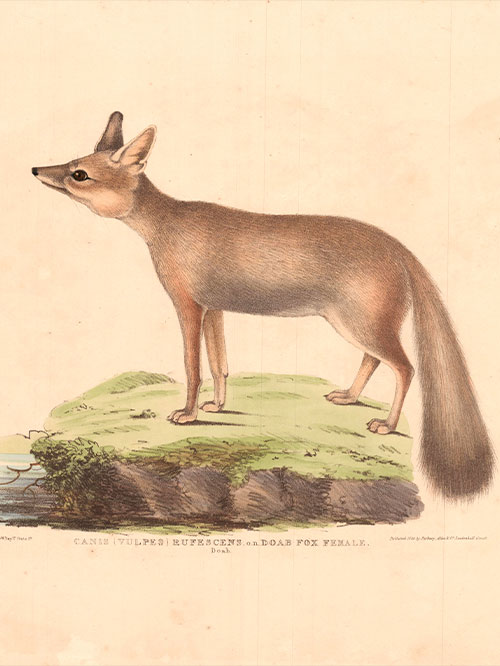
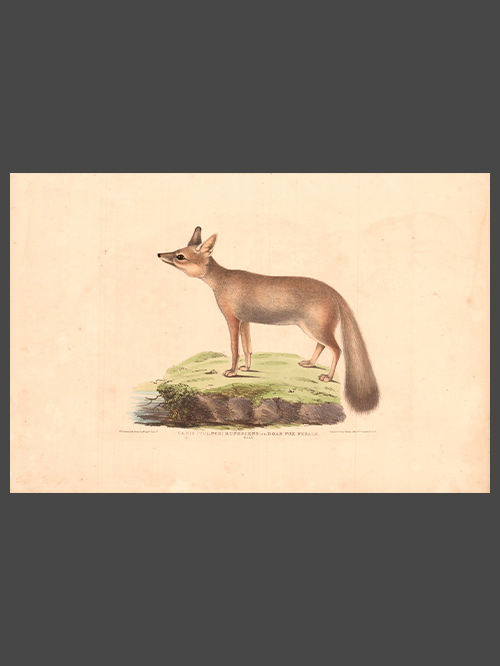
by John Edward Gray’s
From ‘Illustrations of Indian Zoology’
original hand coloured lithograph
Captioned ‘Canis (Vulpes ) Rufescens. Doab Fox Female.‘
John Edward Gray of the British Museum had collaborated with Maj.-Gen. Hardwicke in producing Illustrations of Indian Zoology between 1830 and 1834. He was also the author of several major illustrated works on natural history and commissioned the best artists and printers of the day to illustrate his work. The Illustrations of Indian Zoology is his major work, dedicated to the East India Company, and with the striking plates of bird and animal life in the sub-continent drawn by Waterhouse Hawkins, the noted sporting artist.
Maj.-Gen. Thomas Hardwicke of the Bengal Artillery whilst serving in India from 1778 to 1823 assembled a truly impressive collection of natural history drawings by Indian and European artists whom he engaged to draw flora and fauna. On his retirement he brought the collection with him to England and a thousand of these in many volumes are now in the British library and in the British Museum (Natural History). Bird portraiture predominates in Illustrations of Indian Zoology with a token representation of mammals, reptiles and fishes.
Size (cms): 34 (H) x 48 (L)
Size (inches): 13.5 (H) x 19 (L)
-

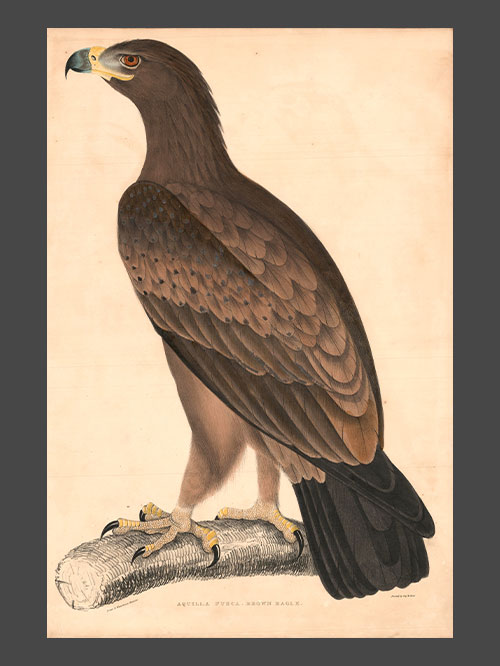
by John Edward Gray’s
From ‘Illustrations of Indian Zoology’
original hand coloured lithograph
Captioned ‘Aquilla Fusca. Brown Eagle.’
John Edward Gray of the British Museum had collaborated with Maj.-Gen. Hardwicke in producing Illustrations of Indian Zoology between 1830 and 1834. He was also the author of several major illustrated works on natural history and commissioned the best artists and printers of the day to illustrate his work. The Illustrations of Indian Zoology is his major work, dedicated to the East India Company, and with the striking plates of bird and animal life in the sub-continent drawn by Waterhouse Hawkins, the noted sporting artist.
Maj.-Gen. Thomas Hardwicke of the Bengal Artillery whilst serving in India from 1778 to 1823 assembled a truly impressive collection of natural history drawings by Indian and European artists whom he engaged to draw flora and fauna. On his retirement he brought the collection with him to England and a thousand of these in many volumes are now in the British library and in the British Museum (Natural History). Bird portraiture predominates in Illustrations of Indian Zoology with a token representation of mammals, reptiles and fishes.
Size (cms): 48 (H) x 34 (L)
Size (inches): 19 (H) x 13.5 (L)

































